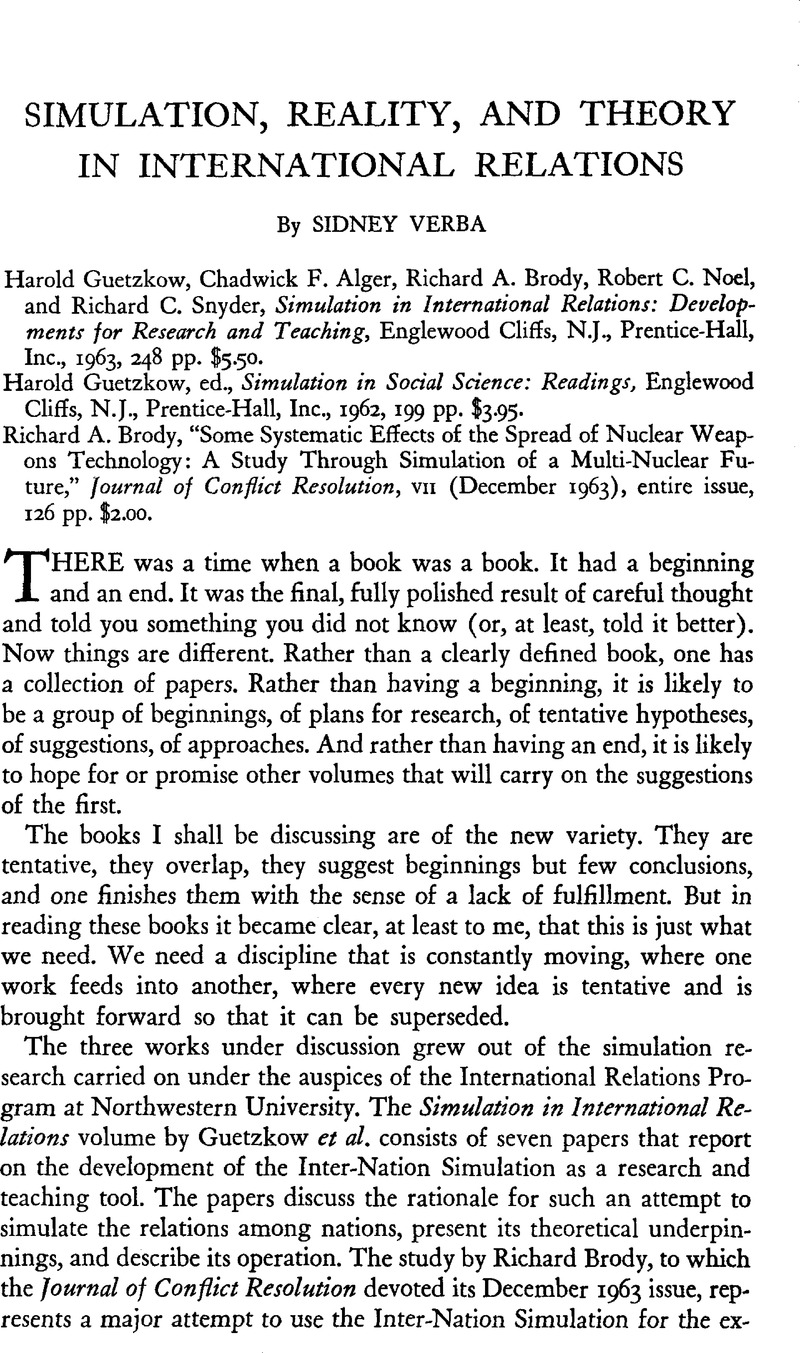Published online by Cambridge University Press: 18 July 2011

1 Goldsen, Joseph M., The Political Exercise: An Assessment of the Fourth Round (Washington, D.C., The RAND Corporation, D-3640-RC, May 1956, mimeographed)Google Scholar.
2 Kaplan, Morton A., Burns, Arthur L., and Quandt, Richard M., “Theoretical Analysis of die ‘Balance of Power’,” Behavioral Science, V (July 1960), 240–52Google Scholar.
3 Ibid.
4 Most of the research discussed in this review involves the attempt to study the relations among states through the use of simulation. But simulation is applicable to studies of the internal politics of nations as well. In fact, though the Inter-Nation Simulation was designed explicitly to study international relations, some of its most interesting aspects — not fully explored by the experimenters, since this was not their prime interest — involve the simulation of office-holding and the transfer of power within nations.
The most direct application of simulation research — in this case, computer simulation— to internal political systems has been in connection with the study of electoral systems. (See Ithiel Pool and Robert Abelson, “The Simulmatics Project,” in Simulation in Social Science, 70–81; McPhee, William N. and Smith, Robert B., “A Model for Analyzing Voting Systems,” in McPhee, William N. and Glaser, William A., eds., Public Opinion and Congressional Elections [New York 1962], 123–52Google Scholar; and McPhee and Jack Ferguson, “Political Immunization,” in ibid., 155–79.) But attempts to simulate interaction patterns within complex social systems of the sort reported by James S. Coleman (“Analysis of Social Structures and Simulation of Social Processes widi Electronic Computers,” in Simulation in Social Science, 61–69) may represent some of the most potentially important uses of simulation for the analysis of political systems.
5 For an example of simulation with a primarily policy-analysis relevance, see the RAND Corporation report cited in footnote 1 above. For examples of simulations focused largely on teaching, see Cohen, Bernard C., “Political Gaming in the Classroom,” Journal of Politics, XXIV (May 1962), 367–81CrossRefGoogle Scholar; and Bloomfield, Lincoln P. and Padelford, Norman J., “Three Experiments in Political Gaming,” American Political Science Review, LIII (December 1959), 1105–115CrossRefGoogle Scholar. The Northwestern Inter-Nation Simulation also has teaching potentialities and has been used for that purpose as well. (See Chadwick F. Alger, “Inter-Nation Simulation in Undergraduate Teaching,” in Simulation in International Relations, 150–89.) In fact, the Inter-Nation Simulation appears to be particularly apt as a teaching device. As Alger points out, the technique is useful in getting students to view international relations from an abstract and theoretical point of view. They come to see the relations among states in terms of general principles rather than specific events, and come to appreciate the problem of bringing conceptual and theoretical order out of the chaos of politics. This, of course, can be done through ordinary teaching techniques, but the advantage of participation by students in a simulation exercise is that they become deeply involved. As those who have taught undergraduates international relations know, what students expect from such a course is current events, drama, inside dope, and a close connection with the contemporary realities of international affairs. Theoretical approaches and abstraction are harder to communicate.
6 The use of the term “real” in contrast to the simulated world may be a bit misleading. The simulation is, of course, also real — there are real people interacting or real computers computing. And we all know that “games” may be deadly serious. The terms “real” and “reality” are used here to contrast what goes on in the simulation with what is simulated. They have no metaphysical implications.
7 See the works on electoral systems cited in footnote 4 above.
8 Further research along these general lines is currently being carried out at the Western Behavioral Sciences Institute at La Jolla, California, under the direction of Wayman J. Crow and Lawrence N. Solomon. (See Crow, Wayman J., “The Use of Inter-Nation Simulation in Experiments,” paper read at a symposium on “Social Psychological Studies of International Behavior,” at the 17th International Congress of Psychology, Washington, D.C., August 1963.)CrossRefGoogle Scholar Their purpose is to test out several strategic doctrines by programming into a simulated world various types of nuclear capabilities. Their work involves somewhat more overt experimental manipulation than is the case in many of the earlier simulation studies, and may represent the next stage in simulation work.
This research suggests an important policy use of such simulation. If one can develop enough confidence in the validity of this form of research, it can be used to test out possible policies in cases where a real world test of the policy is not possible. One could observe to see if the predicted effects of the policy do indeed take place.
9 Charles F. Hermann and Margaret G. Hermann, “The Potential Use of Historical Data for Validation Studies of the Inter-Nation Simulation: The Outbreak of World War I as an Illustration,” prepared under Contract M23 (60530) 25875 A for the United States Naval Ordnance Test Station (China Lake, Calif., August 1961, mimeographed).